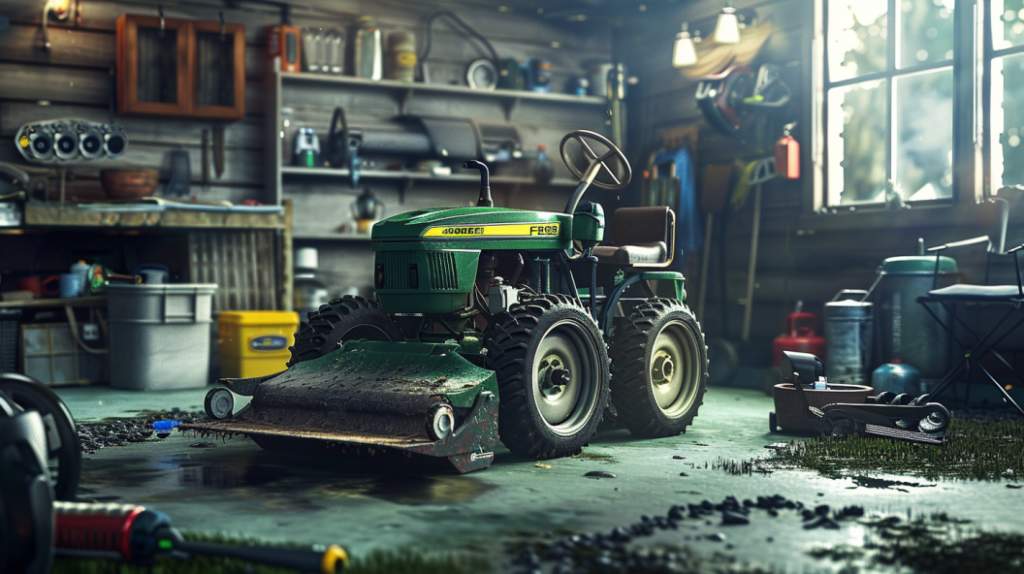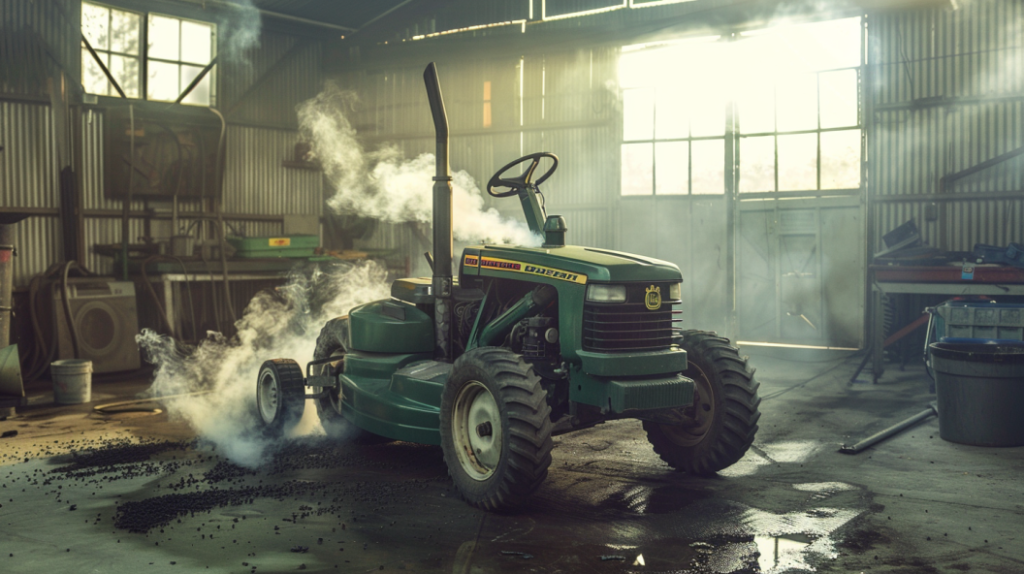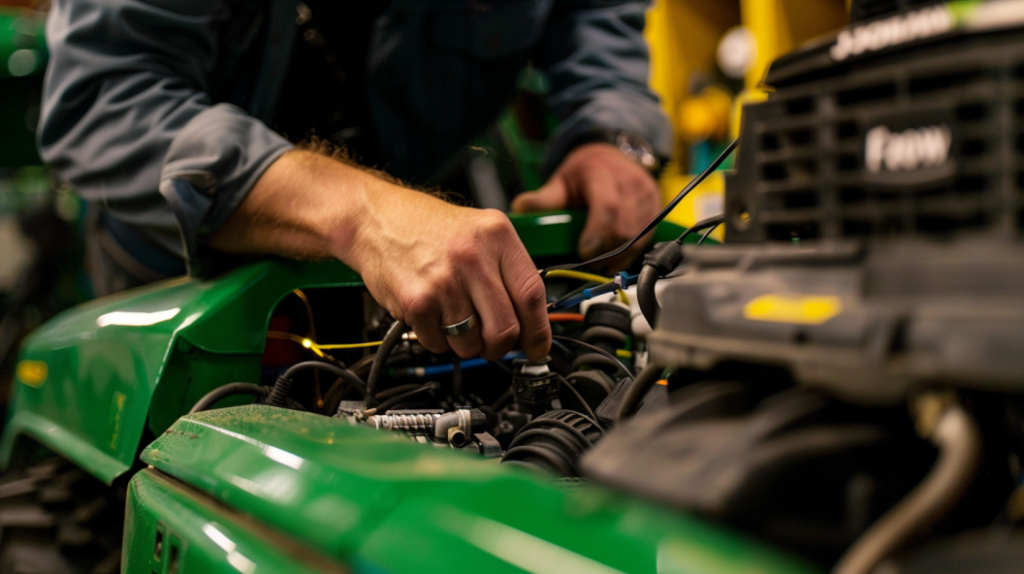If you’ve ever faced frustrating stalls or starting issues with your John Deere F525, you’re not alone. From clogged fuel filters to electrical glitches, this mower can present a range of headaches. But fear not, solutions are at hand. By exploring common problems like belt tension woes and transmission hiccups, you can take steps towards a smoother mowing experience. Stay tuned to uncover key insights that could make a real difference in your John Deere F525’s performance.
Key Takeaways
- Clogged fuel filters can cause stalling; clean or replace filters.
- Check carburetor for issues like starting difficulties; clean if necessary.
- Faulty spark plugs lead to inefficient combustion; replace worn-out plugs.
- Wiring harness problems can cause electrical issues; inspect and repair damaged wires.
- Battery drainage from leaving ignition on; check voltage regulator and wiring regularly.
Engine Troubles

Experiencing frequent stalling and difficulty starting are common engine troubles reported by John Deere F525 owners. These issues often stem from clogged fuel filters or carburetor problems.
To address stalling, first, check the fuel filter for any blockages. If dirty, replace it with a new filter to guarantee proper fuel flow to the engine. Additionally, inspect the carburetor for any debris or varnish buildup that could be obstructing the fuel passages. Cleaning the carburetor thoroughly using a carburetor cleaner can enhance engine performance greatly.
Another culprit behind starting difficulties could be a faulty spark plug. Over time, spark plugs can wear out or become fouled, leading to inefficient combustion. Check the spark plug for signs of wear or deposits. If necessary, replace the spark plug with a new one compatible with the John Deere F525 model. Ensuring a strong spark will facilitate easier starts and smoother engine operation.
Electrical System Malfunctions

You may encounter Wiring Harness Issues, where frayed or damaged wires can lead to electrical failures.
Battery Drainage Problems are common and can result from parasitic draws or a faulty charging system.
Voltage Regulator Failures might cause erratic electrical output, affecting the overall performance of your John Deere F525.
Wiring Harness Issues
One common problem encountered with the John Deere F525 is wiring harness issues, leading to electrical system malfunctions. The wiring harness in your mower serves as the central nervous system for the electrical components, transmitting power and signals throughout the machine.
When the wiring harness is compromised, it can result in various electrical problems such as lights not working, engine not starting, or erratic behavior of the mower’s functions.
To address wiring harness issues, start by visually inspecting the harness for any signs of wear, fraying, or damage. Confirm all connections are secure and free of corrosion. If you identify any damaged wires or connectors, they should be promptly repaired or replaced.
Additionally, check for proper routing of the harness to prevent pinching or rubbing against other components, which can cause short circuits.
Regular maintenance and periodic checks of the wiring harness can help prevent electrical system malfunctions, ensuring smooth operation of your John Deere F525 mower.
Battery Drainage Problems

During operation, the John Deere F525 may encounter battery drainage problems, contributing to electrical system malfunctions.
One common cause of battery drainage in the F525 is leaving the ignition switch in the ‘on’ position when the mower isn’t in use. This continuous power draw can quickly deplete the battery.
Additionally, a faulty voltage regulator can cause excessive charging of the battery, leading to drainage over time.
To address battery drainage issues, make sure that the ignition switch is always turned off when the mower isn’t in operation.
Regularly inspect the wiring harness and connections for any signs of wear or damage that could be causing a short circuit and draining the battery.
It’s also advisable to check the voltage regulator for proper functioning to prevent overcharging.
Voltage Regulator Failures
Voltage regulator failures in the John Deere F525 can lead to various electrical system malfunctions. The voltage regulator is a critical component that guarantees a stable voltage supply to the electrical system. When the voltage regulator malfunctions, it can result in erratic voltage outputs, which may damage sensitive electronic components like the ignition system, lights, and other electrical accessories on the mower.
Common signs of voltage regulator failures include inconsistent or flickering lights, difficulty starting the engine, or even the engine stalling unexpectedly.
To diagnose this issue, you can use a multimeter to test the voltage output from the regulator. If the readings are outside the acceptable range specified in the manual, it indicates a faulty voltage regulator that needs replacement.
To solve voltage regulator failures in your John Deere F525, it’s recommended to replace the regulator with a genuine part from an authorized dealer. Proper installation following the manufacturer’s guidelines is vital to ensure the correct functioning of the electrical system and prevent further damage to other components.
Belt and Pulley Problems
Maintain peak performance by regularly checking belt tension and aligning pulleys on your John Deere F525. Proper belt tension adjustment prevents slipping and premature wear, while pulley alignment checks maintain smooth operation and extend the lifespan of your equipment.
Belt Tension Adjustment
To properly address belt tension adjustment on the John Deere F525 mower, you must first locate the tension adjustment bolt on the belt tensioner assembly. The tension adjustment bolt is typically located near the engine and can be tightened or loosened to adjust the tension of the belt.
Before making any adjustments, make sure the mower is turned off, the key is removed, and the engine has had time to cool down. Using the appropriate wrench, turn the tension adjustment bolt clockwise to increase the tension and counterclockwise to decrease it. It’s essential to achieve the correct tension to prevent slipping, premature wear, or damage to the belt or pulleys.
Regularly check the belt tension as part of your mower maintenance routine, especially after prolonged use or if you notice any unusual noises or vibrations. Proper belt tension ensures excellent performance and longevity of your John Deere F525 mower, allowing you to mow with confidence.
Pulley Alignment Checks
Inspect the alignment of the pulleys on your John Deere F525 mower to identify and address any belt and pulley problems efficiently. Proper alignment is essential for the smooth operation of your mower’s drive system.
Here’s how you can conduct a thorough pulley alignment check:
- Visual Inspection: Start by visually inspecting the alignment of the pulleys. Look for any signs of misalignment, such as the belt not running straight or wobbling.
- Use a Straight Edge: To guarantee accuracy, place a straight edge against the pulley flanges. This will help you determine if the pulleys are aligned correctly or if there’s any deviation.
- Adjust as Needed: If you notice any misalignment during the inspection, make the necessary adjustments. Loosen the pulley mounting bolts and realign the pulleys to ensure they’re parallel to each other.
Regularly checking the pulley alignment on your John Deere F525 mower can prevent premature wear of the belt and pulleys, ultimately extending the lifespan of your equipment.
Steering Issues
When encountering steering issues with your John Deere F525, consider checking the wheel alignment as an important cause. Proper wheel alignment is essential for ensuring smooth and responsive steering performance. Misaligned wheels can lead to difficulties in maneuvering your mower effectively. To diagnose steering problems accurately, inspect the condition of the steering components, such as the tie rods, steering shaft, and steering gear. Look for any signs of wear, damage, or loose connections that could be impacting the steering functionality. Additionally, check the steering wheel itself for any abnormalities or restrictions in movement. Below is a table outlining common steering issues, possible causes, and recommended solutions for your John Deere F525:
| Steering Issue | Potential Cause | Solution |
|---|---|---|
| Uneven Steering | Misaligned Wheels | Adjust Wheel Alignment |
| Stiff Steering | Lack of Lubrication | Grease Steering Components |
| Excessive Steering Play | Worn Steering Components | Replace Damaged Parts |
Transmission Failures
You may encounter common transmission issues with your John Deere F525, such as gear slippage or difficulty shifting. Troubleshooting transmission problems involves checking fluid levels, inspecting the transmission belt, and confirming proper adjustment of the drive linkage.
Addressing these concerns promptly can help prevent further damage and guarantee your mower operates smoothly.
Common Transmission Issues
Transmission failures in the John Deere F525 mower commonly occur due to prolonged use without proper maintenance. Neglecting the transmission system can lead to various issues that hinder the mower’s performance. Here are some common transmission problems you may encounter:
- Guaranteeing Peak Performance: Failure to regularly check and change the transmission fluid can result in overheating and increased wear on transmission components.
- Worn Out Clutch Components: Continuous operation without proper adjustment or replacement of clutch components can lead to slipping, causing a loss of power transmission.
- Dirty Filters: Clogged or dirty transmission filters can restrict fluid flow, leading to inadequate lubrication and cooling of the transmission parts.
Addressing these common transmission issues promptly through regular maintenance and inspections can help prevent costly repairs and extend the lifespan of your John Deere F525 mower. By staying proactive in caring for your transmission, you can secure top-notch performance and efficiency during your mowing tasks.
Troubleshooting Transmission Problems
To troubleshoot transmission failures, start by checking the transmission fluid level and condition. Low or contaminated transmission fluid can lead to poor performance and potential damage. Inspect the transmission belt for wear, cracks, or slipping, as these issues can affect the mower’s ability to transfer power efficiently.
Additionally, examine the transmission pulleys for any signs of damage or misalignment. Keep in mind that addressing transmission problems promptly can prevent further damage and costly repairs. By being proactive in identifying and resolving transmission issues, you can ensure top-notch performance and longevity of your John Deere F525 mower.
Deck Issues
One common problem with the John Deere F525 is related to issues with the deck. When encountering deck issues, it’s important to address them promptly to guarantee the mower’s best performance.
Here are some key points to take into account:
- Uneven Cutting: Uneven cutting is a prevalent deck issue that can stem from an improperly leveled deck. To resolve this problem, adjust the deck height and make sure it’s even on both sides to achieve a uniform cut.
- Bent Blades: Bent blades can result in poor cutting performance and put strain on the mower’s engine. Inspect the blades regularly for any signs of bending or damage, and replace them as needed to maintain cutting efficiency.
- Clogged Deck: A clogged deck can lead to grass clumping and an uneven cut. Regularly clean the underside of the deck to remove any accumulated debris, grass clippings, or moisture that can obstruct the cutting process.
Fuel System Problems
How can you troubleshoot fuel system problems on your John Deere F525 mower efficiently?
If you encounter issues with the fuel system, start by checking the fuel filter for any clogs or dirt accumulation. A dirty fuel filter can restrict fuel flow and cause engine performance issues. Replace the fuel filter if necessary.
Next, inspect the fuel lines for any cracks, leaks, or blockages. Make certain that the fuel lines are securely connected and free of damage.
If you suspect a problem with the fuel pump, test its functionality by checking fuel flow and pressure according to the manufacturer’s specifications.
Additionally, make sure the fuel tank is clean and free of debris that could clog the system. Contaminants in the fuel tank can lead to blockages in the fuel system components. Regularly cleaning the fuel tank can prevent such issues.
If these steps don’t resolve the problem, consider seeking professional assistance to diagnose and repair any underlying fuel system issues efficiently.
Cooling System Failures
To diagnose cooling system failures on your John Deere F525 mower efficiently, start by analyzing the radiator for any signs of leaks or blockages. The cooling system is essential for keeping the engine at the ideal temperature, and any issues can lead to overheating and potential damage.
Here’s what you need to focus on:
- Check Coolant Levels: Make sure the coolant levels are sufficient and that there are no visible signs of leaks in the system.
- Inspect Radiator Hoses: Examine the radiator hoses closely for any cracks, leaks, or bulges that may indicate a problem with the cooling system.
- Clean the Radiator: Regularly clean the radiator to remove any debris or dirt that could obstruct airflow and hinder the cooling process.
Hydraulic System Breakdowns
Examine the hydraulic system on your John Deere F525 mower carefully for any signs of wear or leaks that could lead to potential breakdowns. The hydraulic system is vital for the operation of your mower, controlling the steering and lifting mechanisms. Here are some common issues that may arise with the hydraulic system and their possible solutions:
| Problem | Possible Cause | Solution |
|---|---|---|
| Steering difficulties | Low hydraulic fluid levels | Check and refill hydraulic fluid as per manufacturer’s recommendations |
| Hydraulic leaks | Worn out seals or fittings | Inspect and replace damaged seals or fittings |
| Unresponsive controls | Clogged hydraulic filter | Replace the hydraulic filter to guarantee proper flow |
Regularly inspecting your John Deere F525’s hydraulic system can help prevent these breakdowns, ensuring smooth operation and prolonging the life of your mower. If you encounter any of these issues, addressing them promptly can save you time and money in the long run.
Preventative Maintenance Tips
Inspecting and maintaining the hydraulic system is just one aspect of keeping your John Deere F525 mower in peak condition; implementing preventative maintenance tips is key to guaranteeing its longevity and performance.
To maximize the efficiency and lifespan of your mower, follow these essential preventative maintenance tips:
- Regularly check and change the engine oil: Make sure that the engine oil is at the correct level and free from contaminants. Change the oil as per the manufacturer’s recommendations to keep the engine running smoothly.
- Clean or replace the air filter: A clogged air filter can reduce engine performance and fuel efficiency. Regularly clean or replace the air filter to prevent dust and debris from entering the engine.
- Inspect and tighten bolts and fasteners: Vibrations during operation can cause bolts and fasteners to loosen. Periodically inspect all bolts and fasteners, tightening them as needed to prevent parts from coming loose during mowing sessions.
Frequently Asked Questions
Can the John Deere F525 Be Used for Commercial Landscaping?
Yes, the John Deere F525 is suitable for commercial landscaping tasks. Its durable build, efficient engine, and versatile cutting system make it a reliable choice for professional use.
With proper maintenance and care, this model can handle the demands of commercial landscaping projects, providing you with the power and performance needed to tackle various tasks efficiently.
Its user-friendly design also guarantees ease of operation, boosting productivity on the job.
Is the John Deere F525 Suitable for Hilly Terrain?
For hilly terrain, the John Deere F525 isn’t the most suitable choice due to its design limitations. The mower’s front-mount deck can lead to stability issues on sloped surfaces, affecting performance and safety.
It’s recommended to opt for a mower with a rear-mount deck for better traction and stability on hilly terrain. Consider exploring options that offer enhanced maneuverability and control to tackle such challenging landscapes effectively.
What Attachments Are Compatible With the John Deere F525?
To boost your John Deere F525, opt for compatible attachments like a snow blower, rotary broom, or front blade. These additions will expand the versatility of your machine, allowing you to tackle various tasks with ease.
Guarantee proper installation and maintenance to maximize performance and longevity. Explore the wide range of attachments available to optimize your John Deere F525 for your specific needs and preferences.
How Often Should the Blades Be Sharpened on the F525?
Maintain the blades on your F525 following a schedule based on usage. For peak performance, aim to sharpen them at least twice a season or every 25-30 hours of mowing.
Regular maintenance will guarantee a clean cut, promote healthy grass growth, and extend the life of your mower. Remember, sharp blades make for a smoother cut and prevent stress on the engine, benefiting both your lawn and your machine.
Can the F525 Handle Towing Tasks?
Yes, the John Deere F525 can handle light towing tasks effectively. The mower’s robust design and powerful engine provide sufficient towing capacity for small trailers or carts.
However, it’s important to avoid exceeding the recommended weight limit to prevent strain on the machine. Regular maintenance checks and proper usage will guarantee peak performance and longevity when utilizing the F525 for towing purposes.
Conclusion
To guarantee the peak performance of your John Deere F525 mower, address key issues such as engine troubles, electrical system malfunctions, and belt and pulley problems.
Regular preventative maintenance, such as adjusting belt tension and checking fluid levels, will help prevent potential breakdowns.
Coincidentally, staying on top of these maintenance tasks will also save you time and money in the long run.
Leave a Reply